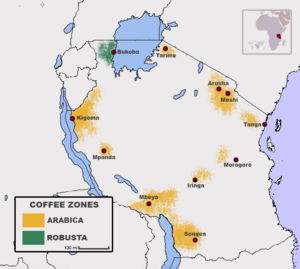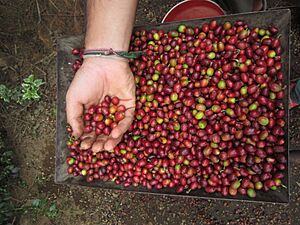Coffee production in Tanzania facts for kids
Coffee production in Tanzania is a very important part of Tanzania's economy. It is the country's biggest crop that is sold to other countries. Tanzania produces about 30,000 to 40,000 tons of coffee each year. About 70% of this is Arabica coffee, and 30% is Robusta coffee.
Arabica coffee grows in nine main areas:
- Iringa
- Kigoma
- Matengo Highlands
- Mbeya
- Mbinga
- Morogoro
- Ngara
- North Kilimanjaro
- Usambara Mountains
Most Robusta coffee grows in the Bukoba area of the Kagera Region. Recently, two new types of coffee plants were found in Tanzania's Eastern Arc Mountains. These are called Coffea bridsoniae and C. kihansiensis. Coffee is usually harvested from October to February. Most coffee farms (90%) are small family farms. The rest are larger plantations. About 270,000 people work in the coffee industry in Tanzania.
Before 1990, the government and farmer groups managed coffee sales. New rules in the 1990s changed how coffee was sold. A plant disease called coffee wilt appeared in 1997. It spread quickly and caused big problems for coffee farmers.
Contents
Coffee's Journey in Tanzania
How Coffee Arrived
Coffee first came to the Tanzania region from Ethiopia in the 1500s. People didn't brew it like we do today. Instead, they used it as a way to feel more energetic. The Haya tribe in northwest Tanzania, in the Kagera Region, were known for using coffee beans. They would boil Robusta beans with herbs. Then they would chew the mixture to get energy. The Haya tribe also used coffee beans as a type of money. Tribal leaders strictly controlled who could grow and use the beans.
Coffee During Colonial Times
When the Germans took control of the region in the late 1800s, coffee became even more important. In 1911, German rulers made people plant Arabica coffee trees in the Bukoba area. The Germans made new laws that took away control from tribal leaders. Coffee seeds became easy for everyone to get. The Haya people were forced to grow other foods like bananas and pineapples. They were also pushed to grow the new Arabica coffee.
In other parts of the country, the Germans introduced coffee near Kilimanjaro and Tanga. Slavery was ended, so tribal chiefs, like the Chagga tribe, who used to earn money from trade, started growing coffee instead.
After World War I, the British took over Tanganyika. They encouraged even more coffee growing. They also changed land ownership laws. The Haya people still resisted, so coffee production in the northwest didn't grow much. However, the Chaga tribe, who had not grown coffee before, became big producers. In 1925, they sold 6,000 tons of coffee worth $1.2 million.
As railways expanded, the British connected with more coffee farmers. In 1925, the Kilimanjaro Native Planters’ Association (KNPA) was formed. This was the first of many farmer groups in Tanzania. These groups helped farmers get better prices for their coffee.
Coffee After Independence
After Tanzania became independent, the government saw great potential in coffee. They wanted to double how much coffee was produced. They gave loans to coffee farms to help them grow more. Large government-owned farms were also started in the south, in Mbozi and Mbinga.
The government also created farmer groups in areas that didn't really need them. Many of these groups failed. Also, a government plan called Ujamaa in the early 1970s moved many people around. This made coffee production harder.
Before 1976, two factories handled all coffee sales. One in Moshi processed Arabica coffee. The other in Bukoba processed Robusta coffee. Then, the coffee was sold at an auction in Moshi. In 1977, all farmer groups were closed. The government created the Coffee Authority of Tanzania. Coffee production dropped a lot because of too much government control and high costs.
In the early 1990s, new rules allowed private companies to get involved. This made the coffee industry much more efficient. The Tanzanian Coffee Board was brought back. It now gives out permits and licenses. Growing and selling coffee became fully independent. The board also grades coffee beans and runs the Moshi Coffee Auction.
How Coffee is Graded and Sold
Coffee Grading
Tanzania uses a British system to grade coffee. Coffee beans are sorted by their shape, size, and how dense they are.
There are eleven main grades:
- AA
- A
- B
- PB
- C
- E
- F
- AF
- TT
- UG
- TEX
Selling Coffee
Farmers can sell their coffee in three ways. First, they can sell it directly to private buyers, village groups, or coffee cooperatives. This is common for small farmers who don't produce a lot of coffee.
Once private buyers or cooperatives have enough coffee, they can sell it at the Moshi Coffee Auction. Or, they can export it directly to other countries. Some top-grade coffee growers can skip the auction. They can sell their coffee directly to companies in other countries that roast coffee. The Coffee Board of Tanzania created this rule. It helps farmers and local companies build lasting relationships with international buyers.
Moshi Coffee Exchange
The Moshi Coffee Exchange is in Moshi, in the Kilimanjaro Region. It holds a coffee auction every week for nine months of the year. Auctions happen on Thursdays. All local exporters who don't have a special license must sell their coffee through this auction. Licensed exporters attend the auction. There are no limits on how much coffee an exporter can buy.
Coffee Production and Sales
Tanzania's economy relies heavily on farming. Agriculture makes up 24% of the country's total income. In 2014, coffee exports were worth $186 million, which was 3.3% of all Tanzania's exports. More than 90% of the coffee comes from small family farms, not large estates. Coffee farming provides jobs for 400,000 families. It directly affects over 2.4 million people. Coffee is the second most valuable farm export after tobacco.
The main buyers of Tanzanian coffee are Japan (22%), Italy (19%), and the United States (12%). Germany used to buy the most Tanzanian coffee. But with better marketing and quality control, Japan and the United States now buy the largest share.
The Tanzanian Coffee Board faces many challenges. It works hard to make Tanzanian coffee more famous. Most of Tanzania's coffee is mixed with other brands. This makes it lose value in the world market. However, in Japan, Tanzanian coffee has a special brand called "Kilimanjaro coffee." In 1991, the All Japan Fair Trade Council decided that all Tanzanian coffee can be called "Kilimanjaro coffee." This is true no matter where in Tanzania it was grown. Also, any coffee blend with 30% or more Tanzanian beans can use this name. This big step helped increase the value of Tanzanian coffee in Japan. Today, Japan is the biggest buyer of Tanzanian coffee.
People in Tanzania don't drink as much coffee as the country exports. Coffee is more expensive than tea in Tanzania. So, most people drink tea. However, local coffee drinking is growing. It went from 2% of production in 2003 to 7% in 2014.
Tanzania Coffee Research Institute
The Tanzania Coffee Research Institute (TaCRI) was started in 2000. It is a non-profit government company. It began working in September 2001. The government owns most of the institute. Other parts of the coffee community also have a say in it. TaCRI is a non-profit group. It relies on money from the government, donors, and selling farming tools.
Coffee production in Tanzania has been going down since the 1990s. TaCRI's job is to help the coffee industry grow again. It aims to increase the money earned from coffee exports. The institute helps thousands of farmers. It shares new technology and teaches farmers better ways to grow coffee. This helps farmers keep up with the latest and best practices in coffee farming.
Images for kids







